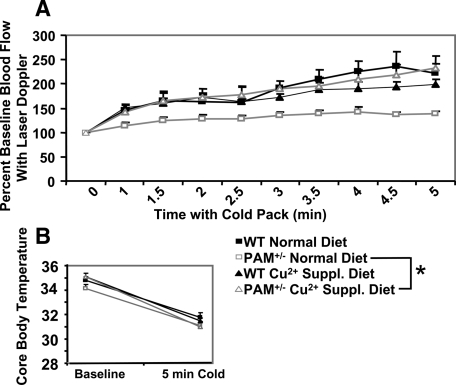Figure 6.
A, PAM+/− (total n = 15; n/group = 7–8, in white) and WT (total n = 14; n/group = 6– 7, in black) mice were anesthetized with isoflurane and a laser Doppler probe was used to monitor blood flow through their tail veins before and during a 5-min cold exposure (direct contact with ice packs stored at −20 C). The averaged data are presented as a percentage of baseline blood flow, and the error bars indicate the sem. A one-way ANOVA of repeated measures revealed a significant difference separating the genotypes (P < 0.0005). Additional analysis with a two-way ANOVA of repeated measures indicated that 14 d of supplementation (Suppl.) of dietary copper fully rescued the PAM+/− deficit in cold-induced vasoconstriction without altering the WT level of cold-induced vasoconstriction. Specifically, a significant overall three-way interaction between blood flow, genotype, and dietary copper treatment (P = 0.012) was seen. Moreover, statistical analysis of the between subject factors revealed significant interaction between genotype and dietary copper treatment (P = 0.031). B, Core body temperature at baseline and after 5 min of cold exposure are shown.

